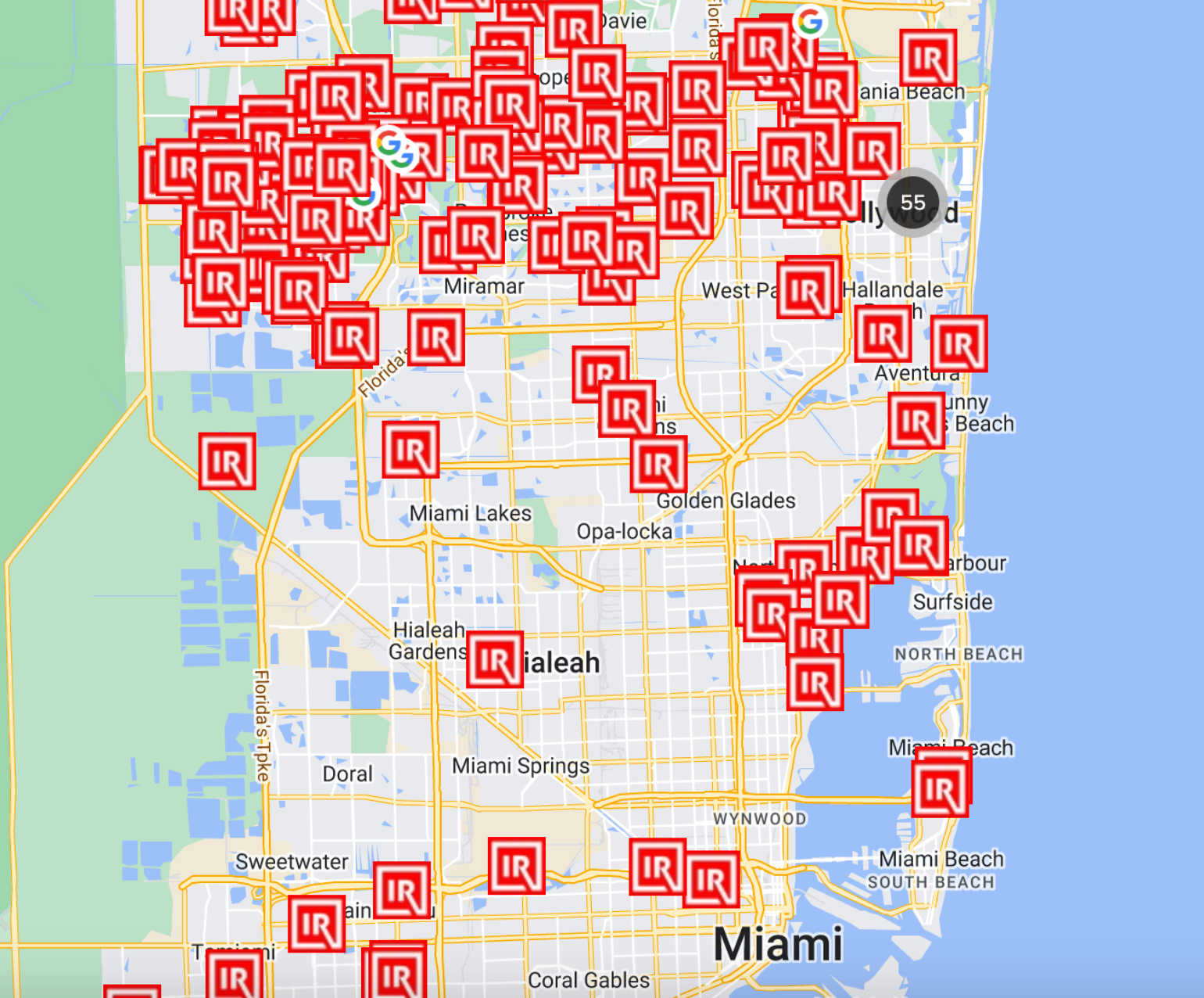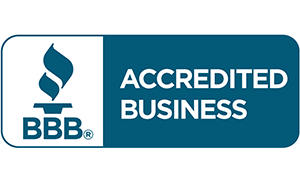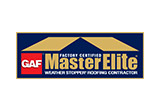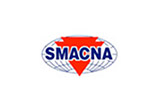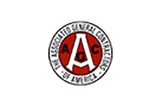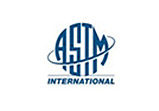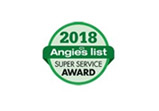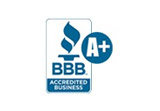Maintaining a structurally sound and well-maintained roof is essential for any commercial property. The roof not only protects the business assets and occupants but also safeguards the overall integrity of the building structure. However, over time, even the most durable commercial roofs can experience wear and tear, leading to the need for repairs. In this page, we will delve into the world of commercial roof repairs, exploring the importance of timely interventions, common issues that necessitate repairs, and the benefits of entrusting these crucial tasks to professional roofing experts.
Commercial roof repairs encompass a wide range of services aimed at restoring the functionality, durability, and longevity of commercial roofing systems. From addressing minor leaks and damaged flashing to repairing sections affected by storm damage or general wear, these repairs play a vital role in ensuring a watertight, weather-resistant, and secure roofing system for businesses of all sizes. By proactively addressing and rectifying roof issues, commercial property owners can mitigate potential risks, prevent more extensive damage, and ultimately save substantial costs in the long run. Join us as we explore the intricacies of commercial roof repairs, empowering you with valuable insights to make informed decisions and protect the most crucial aspect of your business: its shelter.
After reading this article, you will have expert answers to the following questions:
- How do I determine if my commercial roof needs repairs?
- What are the common causes of commercial roof damage?
- How long does a commercial roof repair typically take?
- What is the cost of commercial roof repair, and what factors contribute to the overall cost?
- Are there different types of commercial roofing materials, and which one is most suitable for my building?
- Do I need to temporarily close my business during the roof repair process?
- Are there any warranties or guarantees provided for the commercial roof repair work?
- Can I schedule regular maintenance to prevent future roof issues?
- Are there any regulations or permits required for commercial roof repairs?
How do I determine if my commercial roof needs repairs?
As a business owner or property manager, it’s crucial to regularly assess the condition of your commercial roof to identify potential issues before they escalate into major problems. Knowing how to determine if your commercial roof needs repairs can save you time, money, and headaches in the long run. Here are some key indicators to consider:
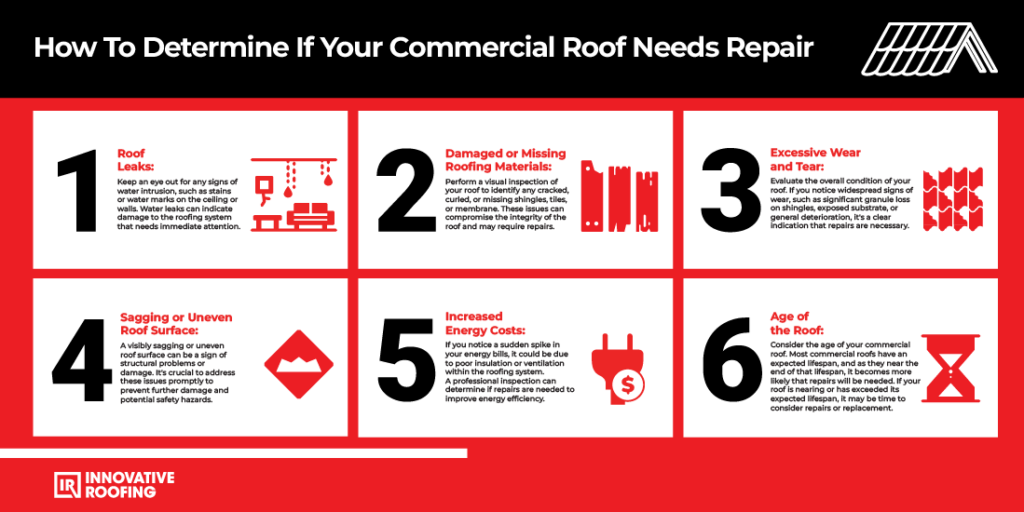
Roof Leaks
Keep an eye out for any signs of water intrusion, such as stains or watermarks on the ceiling or walls. Water leaks can indicate damage to the roofing system that needs immediate attention.
Roof leaks can occur due to various reasons, and it’s important to promptly identify and address them to prevent further damage. Here are some common causes of roof leaks:
- Damaged or Missing Shingles: Aging, severe weather conditions, or poor installation can lead to damaged or missing shingles. When shingles are compromised, water can seep through the roof and cause leaks.
- Faulty Flashing: Flashing is a thin metal material installed around roof openings and joints, such as chimneys, vents, and skylights. If the flashing becomes damaged, corroded, or improperly installed, it can create vulnerabilities and allow water to penetrate the roof.
- Clogged Gutters: Gutters play a crucial role in directing water away from the roof. However, if they become clogged with debris, such as leaves, branches, or dirt, water can accumulate and overflow onto the roof, leading to leaks.
- Damaged Roof Valleys: Roof valleys are the intersections where two sloping roof sections meet. If these areas are compromised due to age, improper installation, or damage from heavy rainfall or debris, water can penetrate the roof and cause leaks.
- Improper Roof Installation: If a roof is not installed correctly, it can result in various issues, including inadequate sealing, improper flashing installation, or incorrect placement of underlayment. These installation errors can lead to roof leaks over time.
- Condensation and Moisture Buildup: Improper ventilation in the attic can cause condensation and moisture buildup
Damaged or Missing Roofing Materials
Damaged or missing roofing materials can occur due to various factors. Severe weather events such as high winds, heavy rain, or hailstorms can cause significant damage to roofing materials, leading to cracks, breaks, or dislodgment. Over time, aging and wear can also take a toll on roofing materials as they become brittle, curl, or lose their protective granules. Improper installation techniques during the initial roofing process can result in premature damage or detachment of materials. Impact damage from falling debris or tree branches, foot traffic on the roof, and neglecting regular maintenance can further contribute to the deterioration and displacement of roofing materials. To prevent these issues, it is important to conduct regular inspections, address minor problems promptly, and consult with a professional roofing contractor for necessary repairs or replacements.
Perform a visual inspection of your roof to identify any cracked, curled, or missing shingles, tiles, or membrane. These issues can compromise the integrity of the roof and may require repairs.
Excessive Wear and Tear
Excessive wear and tear on a commercial roof can occur due to various reasons. Over time, the natural aging process takes its toll, and exposure to elements like UV radiation, temperature fluctuations, and weather conditions can contribute to the degradation of roofing materials. Additionally, frequent foot traffic on the roof for maintenance or equipment installations can cause abrasion and damage to protective layers, leading to accelerated deterioration. Poor maintenance practices, such as inadequate inspections, delayed repairs, and neglecting necessary maintenance tasks, can also contribute to increased wear and tear. Harsh weather conditions, including heavy rain, snow, ice, hail, and high winds, pose additional challenges and can lead to damage and loosening of roofing materials. Moreover, improper installation techniques during the initial roofing process can compromise the roof’s integrity and contribute to premature wear and tear. To minimize excessive wear and tear, it is crucial to prioritize regular maintenance, conduct professional inspections, address issues promptly, and seek expert guidance for necessary repairs, maintenance, or replacement.
Evaluate the overall condition of your roof. If you notice widespread signs of wear, such as significant granule loss on shingles, exposed substrate, or general deterioration, it’s a clear indication that repairs are necessary.
Sagging or Uneven Roof Surface
Sagging or uneven commercial roofs can be caused by various factors. Structural issues, such as insufficient support or compromised integrity, can result in the roof’s unevenness or sagging. Excessive weight from sources like standing water, or additional equipment without proper reinforcement can also lead to roof sagging. Prolonged exposure to water or moisture can weaken the roof’s structure over time, causing sagging or unevenness. Poor installation, age-related deterioration, and overloading or overuse of the roof beyond its intended capacity are additional reasons for roof unevenness. Promptly addressing sagging or uneven commercial roofs is crucial to prevent further damage and ensure the safety of the property.
A visibly sagging or uneven roof surface can be a sign of structural problems or damage. It’s crucial to address these issues promptly to prevent further damage and potential safety hazards.
Increased Energy Costs
A bad roofing condition can have a direct impact on energy costs. Insufficient insulation caused by a damaged or deteriorated roof can result in heat loss during colder months and heat gain during hotter months, leading to increased heating and cooling needs. This increased demand for climate control can lead to higher energy consumption and elevated costs. Additionally, gaps or cracks in a damaged roof can cause air leakage, allowing conditioned air to escape or outside air to infiltrate the building. This air leakage puts a strain on the HVAC system, requiring it to work harder to maintain desired indoor temperatures, thereby increasing energy usage and expenses. Inadequate ventilation due to a damaged or improperly ventilated roof can trap heat and moisture inside the building, causing the HVAC system to run less efficiently and contributing to higher energy consumption. By ensuring a well-maintained roof with proper insulation and ventilation, property owners can improve energy efficiency, reduce energy costs, and create a more comfortable indoor environment
If you notice a sudden spike in your energy bills, it could be due to poor insulation or ventilation within the roofing system. A professional inspection can determine if repairs are needed to improve energy efficiency.
Age of the Roof
Consider the age of your commercial roof. Most commercial roofs have an expected lifespan, and as they near the end of that lifespan, it becomes more likely that repairs will be needed. If your roof is nearing or has exceeded its expected lifespan, it may be time to consider repairs or replacement.
Remember, it’s always recommended to consult with a professional roofing contractor for a thorough assessment of your commercial roof. They have the expertise and experience to accurately identify any issues and provide appropriate recommendations for repairs or maintenance. Regular inspections and proactive repairs can help prolong the life of your commercial roof and protect your investment.
What are the common causes of commercial roof damage?
Florida’s Unique Weather Impact on Commercial Roofing
Florida’s unique climate and weather patterns present specific challenges that can lead to commercial roof damage. One common cause is intense sunlight and UV radiation. The strong and prolonged exposure to sunlight in Florida can cause roofing materials to deteriorate, leading to cracking, warping, or degradation over time. Additionally, the frequent occurrence of heavy rainstorms, tropical storms, and hurricanes in Florida can subject commercial roofs to high winds, driving rain, and potential debris impact. These weather events can result in lifted or missing shingles, damaged flashing, and even structural damage. The high humidity levels in Florida also contribute to the growth of algae, moss, and mold, which can deteriorate roofing materials and compromise the roof’s integrity. Proper maintenance, regular inspections, and taking preventive measures, such as installing sturdy roofing materials designed to withstand high winds and UV exposure, are essential for protecting commercial roofs in Florida’s challenging climate.
Anywhere Else In The United States
Commercial roofs can suffer damage due to a variety of factors. One common cause is severe weather conditions such as heavy rain, strong winds, hailstorms, or snow accumulation. These weather events can cause significant damage to roofing materials, leading to leaks, cracks, or even complete dislodgment of shingles or tiles. Another frequent cause of commercial roof damage is poor installation or workmanship. If the initial installation was not done correctly, it can result in various issues such as improper sealing, inadequate flashing, or incorrect placement of roofing materials. Over time, these installation errors can compromise the integrity of the roof and lead to leaks, water infiltration, or structural damage.
Lack Of Maintenance Impacts Roofs Everywhere
Lack of regular maintenance is another factor that contributes to commercial roof damage. Without proper inspections, cleaning, and timely repairs, minor issues can escalate into major problems. Over time, neglecting maintenance can result in the accumulation of debris, clogged gutters, or unchecked deterioration of roofing materials, leaving the roof vulnerable to leaks and damage. Additionally, foot traffic on the roof, especially in commercial settings where maintenance or equipment installations are common, can also cause wear and tear on the roofing system. The constant walking or movement on the roof can weaken the materials, leading to cracks, punctures, or loose roofing components. To prevent commercial roof damage, it is crucial to address these causes by implementing regular maintenance programs, conducting professional inspections, and promptly repairing any identified issues.
How long does a commercial roof repair typically take?
The length of time it takes to repair a commercial roof can vary significantly depending on a variety of factors. These factors include the size of the roof, the complexity of the repair, the type of roofing material, and the extent of the damage. For minor repairs, such as patching small leaks or replacing a few damaged shingles, the repair might be completed within a day or two. However, for more extensive repairs, such as fixing large leaks, replacing substantial areas of the roof, or dealing with structural issues, the process can take several days to several weeks.
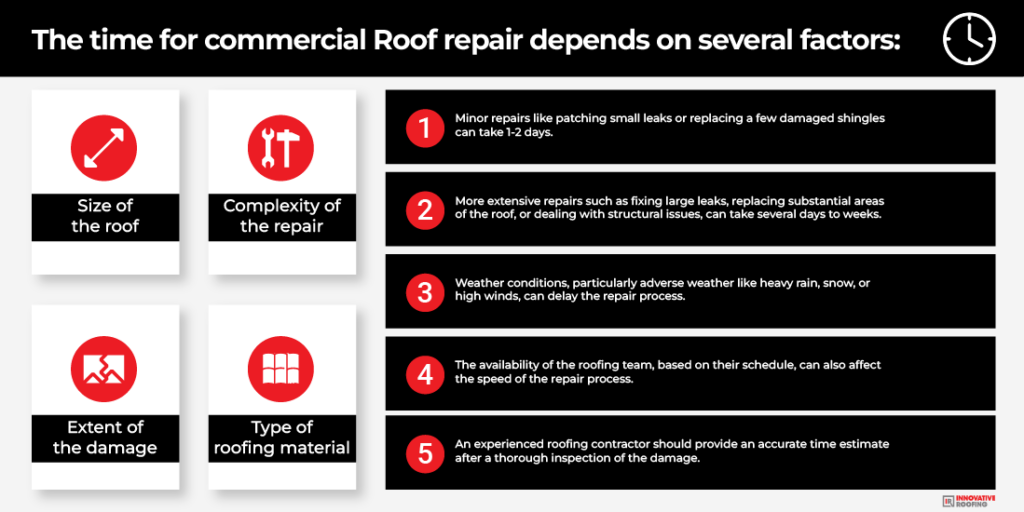
Moreover, it’s important to consider that weather conditions can also impact the timeline of a commercial roof repair. Adverse weather, such as heavy rain, snow, or high winds, can delay the repair process, particularly for outdoor work. It’s also worth noting that professional roofers often schedule their projects well in advance, so the availability of the roofing team can affect how quickly the repair job can be started. Despite these variations, an experienced roofing contractor should be able to provide an accurate estimate of the time needed for the repair after performing a thorough inspection of the roof and understanding the extent of the damage.
What is the cost of commercial roof repair, and what factors contribute to the overall cost?
The cost of commercial roof repair can vary significantly, largely dependent on the size of the building, the extent of the damage, the type of roof, and local labor costs. As of September 2021, (during pandemic) minor roof repairs might cost anywhere from a few hundred to a few thousand dollars. More extensive repairs or replacement could easily run into the tens of thousands of dollars.
The financial outlay for commercial roof repairs is subject to various contributing elements, and understanding these factors can help you budget accordingly. Firstly, the scope of the damage to be rectified plays a crucial role in determining the cost. Small repairs, such as patching up minor leaks or replacing a handful of damaged shingles, will generally be less expensive than more comprehensive repairs. More extensive issues, like substantial leaks, replacing large sections of the roof, or addressing underlying structural problems can significantly increase the cost.
Typically, the cost of commercial roof repair is calculated per square foot. For example, basic repair work might range from $3.00 to $5.00 per square foot, while more complex jobs could cost $20.00
Secondly, the type of roofing material used can greatly influence the repair cost. Traditional materials such as asphalt shingles tend to be less expensive than premium options like metal, tile, or high-end synthetic materials. Another aspect to consider is labor cost which is often determined by the complexity of the job. Complex repairs that require more specialized labor or more time to complete will generally be more expensive. Additionally, accessibility to the roof, permits needed, and whether any structural changes are required will also affect the final price. An experienced roofing contractor should be able to give a detailed and accurate cost estimate after a comprehensive assessment of the roof’s condition and the necessary repairs.
For the most accurate pricing, it’s best to get a quote from a professional roofer who can assess your specific needs and local cost factors.
Are there different types of commercial roofing materials, and which one is most suitable for my building?
Commercial buildings indeed have a wide array of roofing materials to choose from, each with its unique advantages, disadvantages, and suitability for specific building types. To determine which roofing material is most appropriate for your building, you’ll need to consider several factors such as the slope of your roof, your region’s climate, your budget, and the specific requirements of your building.
One common type of commercial roofing material is metal. Metal roofs are known for their durability and long lifespan, often lasting 40-60 years or even longer with proper maintenance. They are resistant to fire, wind, and other harsh weather conditions, making them suitable for a wide range of climates. Metal roofs are also energy-efficient, as they reflect sunlight and help keep the building cooler, reducing energy costs. However, they can be more expensive upfront than other materials.
Thermoplastic Olefin (TPO) and Polyvinyl Chloride (PVC) are popular choices for flat roofs. These are single-ply roofing systems that are heat-welded and provide excellent resistance to leaks. They are also resistant to UV radiation, chemical exposure, and high winds. These characteristics make TPO and PVC roofs a particularly good fit for buildings in areas that experience extreme weather conditions.
Built-Up Roofing (BUR) systems, also known as “tar and gravel” roofs, are another option. These roofs are built with alternating layers of tar or asphalt and supporting fabrics, topped off with a layer of gravel. They offer excellent protection against water, UV damage, and harsh weather. However, they are heavy, so the building structure must be capable of supporting this weight.
Ethylene Propylene Diene Monomer (EPDM) roofs, often referred to as rubber roofs, are another option for flat roofs. They are known for their durability and ease of maintenance. EPDM roofs are also highly resistant to UV radiation and extreme weather conditions.
In conclusion, the best type of commercial roofing material for your building will depend on your specific circumstances and needs. It’s always a good idea to consult with a professional roofing contractor to help you make the best decision.
Do I need to temporarily close my business during the roof repair process?
Whether or not you’ll need to temporarily close your business during a commercial roof repair process depends on several factors, including the scope of the work, the nature of your business, and the layout of your building.
As yourself the following questions and find out whether you should consider halt operations or even closing temporarily your business due to roofing repairs:
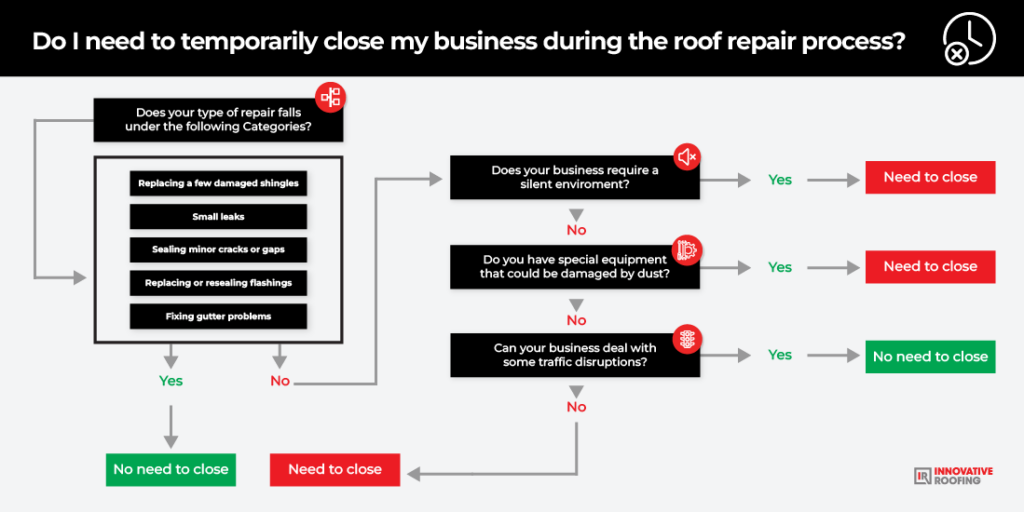
If the repairs are minor and can be completed within a short period of time, you might be able to keep your business open, perhaps with some slight disruptions. Roofing contractors often work with businesses to minimize disruption, scheduling noisy or invasive work during off-peak hours or arranging the workflow to keep entrances and main areas clear. However, it’s important to remember that even minor roofing work can generate dust, noise, and occasional vibrations, which could disrupt certain types of businesses.
If the repairs are minor, you might be able to keep your business open. Roofing contractors often work with businesses to minimize disruption, scheduling noisy or invasive work during off-peak hours or arranging the workflow to keep entrances and main areas clear.
Types of Minor Roof Repairs
- Replacing a few damaged shingles: Shingles can become cracked, curled, or even lost due to weather and other environmental conditions. Replacing a handful of damaged shingles is considered a minor repair.
- Repairing small leaks: If a leak is localized to one area and hasn’t caused extensive water damage, it is generally considered a minor repair to fix the leak and the small amount of surrounding damage.
- Sealing minor cracks or gaps: Over time, minor cracks or gaps may appear around roof installations such as skylights, vents, or chimneys. Sealing these to prevent water infiltration is usually a minor repair.
- Replacing or resealing flashings: Flashings, which are installed around features like chimneys and vents, can sometimes become loose or damaged. Repairing or replacing these components is generally considered a minor task.
- Fixing gutter problems: This could involve reattaching a loose gutter, replacing a small section of guttering, or cleaning blocked gutters.
- Flat Roof Coatings: A commercial flat roof coating is a protective layer that is applied to a flat or low-sloped commercial roof. It is designed to extend the life of the roof, enhance its performance, and in some cases, improve the building’s energy efficiency.
On the other hand, if the repairs are extensive and require significant amounts of time, it may be more prudent to close your business temporarily. This is especially true if there are potential safety risks to employees or customers, or if the nature of your business requires a quiet, dust-free environment that cannot be maintained during the repair work.
In many cases, a professional roofing contractor can provide guidance on this matter. They can assess the scope of the repairs and advise you on the potential disruptions, allowing you to make an informed decision about whether to remain open or close temporarily. The contractor might also be able to suggest strategies to reduce disruption if you choose to stay open. In the end, your decision should balance the need for the repairs with the operational needs of your business and the comfort and safety of your employees and customers.
Are there any warranties or guarantees provided for the commercial roof repair work?
Yes, warranties or guarantees are often provided for commercial roof repair work, but the specifics can vary significantly depending on the roofing contractor and the type of repair or materials used. These warranties serve as a form of assurance to you, the property owner, that you’re getting quality work and that any subsequent issues related to the repairs will be addressed.
A contractor’s warranty, also known as a workmanship warranty, covers the labor involved in the roofing project. This means that if there are any issues with the repair work within the specified warranty period, the contractor will come back to correct the issue at no additional cost to you. The length and terms of a contractor’s warranty can vary, but they typically range from one to several years.
In addition to the contractor’s warranty, there may also be a manufacturer’s warranty. This covers the roofing material itself, protecting you against defects in the manufacturing process. These warranties can be particularly long-lasting, often covering the materials for 10, 20, or even more years. However, they typically only cover the cost of the materials, not the labor involved in making any necessary repairs.
It’s essential to carefully read and understand any warranty provided with your roof repair work. Not all warranties are created equal, and they may contain specific exclusions or maintenance requirements to remain valid. If you’re uncertain about any aspect of your warranty, don’t hesitate to ask your contractor for clarification. Remember, the goal of a warranty is to give you peace of mind that your investment in your commercial roof is protected.
How often should I schedule regular maintenance to prevent future roof issues?
Ensuring the longevity and functionality of your commercial roof is directly related to how often you schedule regular maintenance checks. Regular maintenance can help identify minor issues before they escalate into major problems that could require extensive repairs or even a roof replacement.
Generally, it’s recommended to have a professional roofing contractor inspect your roof at least twice a year, ideally in the spring and fall. These seasons are excellent times for a check because they follow the harsh winter and summer months, when weather can be especially taxing on a roof. An inspection during these times allows any damage from these harsher seasons to be promptly identified and repaired.
However, it’s worth noting that the frequency of maintenance can depend on several factors including the age of the roof, the type of roofing material, the climate and weather conditions of your area, and any warranties or service contracts that might be in place. Older roofs, roofs in areas with harsh weather, and roofs with known minor issues may require more frequent checks.

In addition to these regular inspections, it’s a good idea to schedule a professional inspection after any severe weather event, such as a storm or high winds, which can cause immediate and significant damage to your roof.
Regular maintenance should also include routine tasks such as clearing debris from the roof and gutters, trimming overhanging tree branches, and checking flashings and seals around roof penetrations.
In conclusion, while biannual inspections are a good rule of thumb, the specific needs of your roof may necessitate more frequent checks. Always work with a professional roofing contractor to create a maintenance schedule that is best suited to your specific roof and situation.
A Special Note For Florida Commercial Owners
Given the unique weather conditions in Florida, more frequent inspections might be necessary to ensure the longevity of a commercial roof. Florida’s climate is characterized by high humidity, intense sun, frequent rain, and occasional hurricanes or tropical storms, all of which can significantly impact a roof’s lifespan and integrity.
Due to Florida’s specific climate conditions, an additional inspection may be beneficial after the hurricane season, which runs from June 1st through November 30th. This additional inspection can help identify and address any damage caused by severe weather events promptly.
Additionally, anytime there is a severe storm or hurricane, it’s advised to schedule an inspection immediately afterward to assess for any damage, even if it is outside of your regular inspection schedule. Severe weather can cause immediate and significant damage that should be addressed as soon as possible to prevent further problems.
Lastly, regular maintenance should include routine tasks such as clearing debris from the roof and gutters and checking flashings and seals around roof penetrations. These tasks can often be performed by building maintenance staff, but any suspected issues or damage should be evaluated by a professional roofer.
Are there any regulations or permits required for commercial roof repairs?
Yes, there are often several regulations and permits that must be adhered to when undertaking commercial roof repairs. These rules vary by location, so it’s crucial to familiarize yourself with the specific regulations in your city or county before starting any roofing project.
Firstly, you will generally need a permit to carry out significant commercial roof repairs or replacements. The permit process is designed to ensure that all construction work, including roofing, complies with local building codes and safety standards. While minor repairs like fixing a small leak or replacing a few shingles may not require a permit, larger projects like replacing a substantial portion of the roof or installing a new roofing system typically will.
Building codes also come into play with commercial roofing. These codes set out the requirements for various aspects of the roof, such as the type of materials that can be used, how the roof should be installed, and standards for wind and fire resistance. Your roofing contractor should be familiar with these codes and ensure that all work is compliant.
Furthermore, if your building is located in a historic district or is a listed or protected structure, there may be additional regulations to preserve the building’s historic character. This could limit the type of roofing materials you can use or require additional approval processes before work can begin.
Lastly, it’s essential to note that failing to comply with these regulations and permit requirements can result in fines, delays, and may even affect your insurance coverage. Therefore, it’s always recommended to work with a professional and licensed roofing contractor who is familiar with local regulations and can ensure that all work is carried out to code. It’s always better to take the time to secure the necessary permissions upfront than to deal with potential problems down the line.






